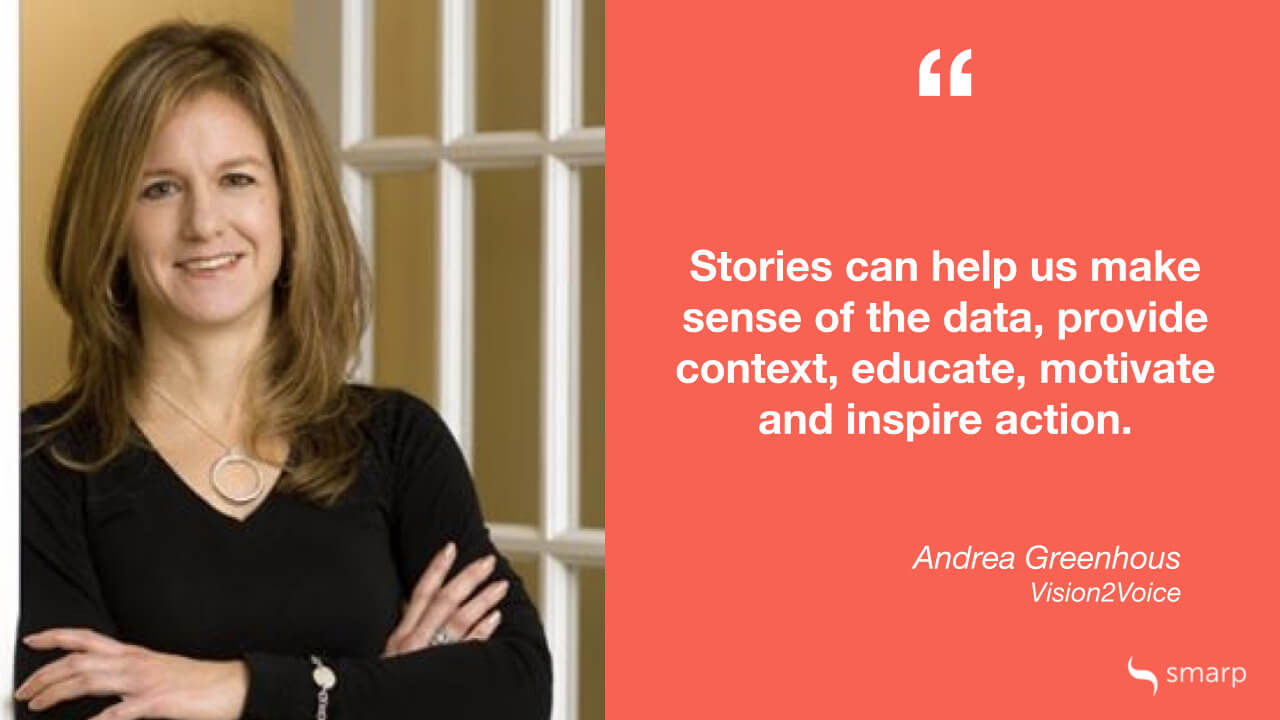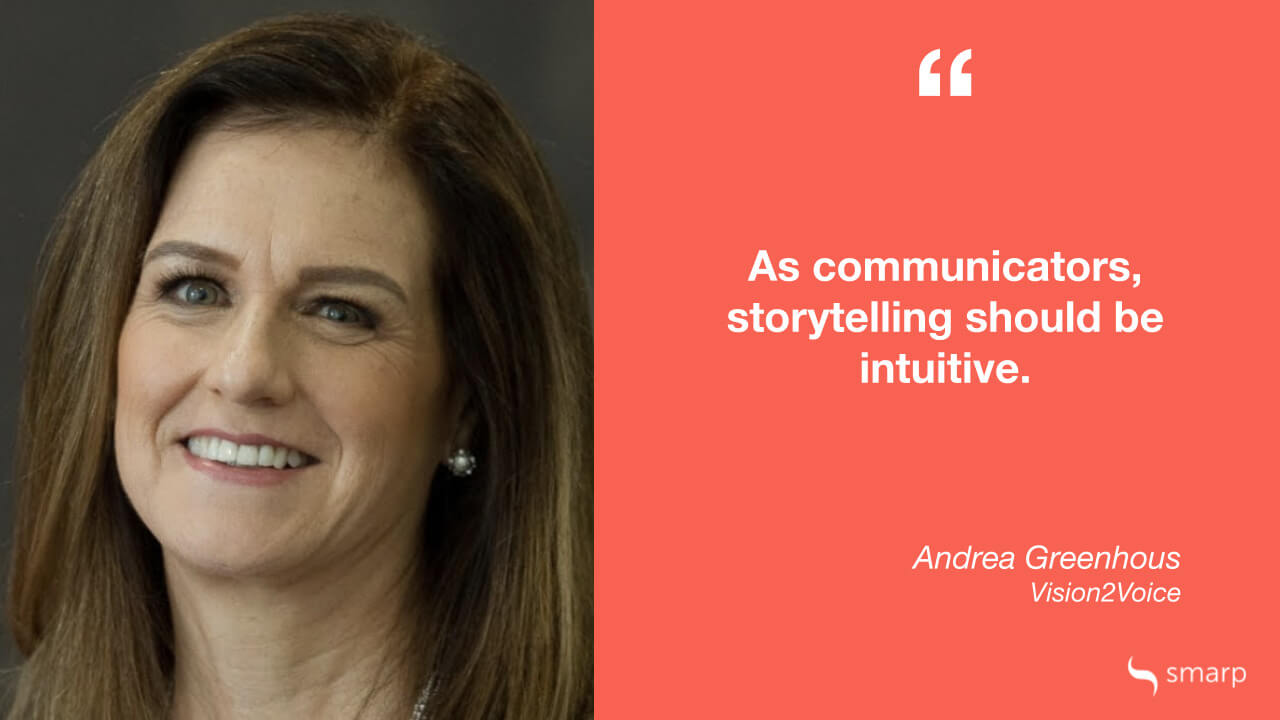We asked Andrea Greenhous, Founder and Chief Internal Communications Strategist at Vision2Voice, to explain the secret ingredient internal communications often miss when measuring success. According to her, using storytelling can bring KPIs and data to life and have a bigger impact than facts and numbers alone.
I recently presented a case study to a group of graduate students at the University of Florida. I decided the best way to teach them about the value of good content was to share a story. I told the class about a project where my team solved a million-dollar problem and achieved some tremendous business results with a simple solution.
When I turned to my next task, which was to write this blog for Smarp on business outcomes, I had a lightbulb moment: we need to use storytelling to truly demonstrate how internal communications can solve problems and drive business success.
Don’t get me wrong – over my entire career I have been a huge advocate for data and metrics. No one gets more excited than I do when I have data to prove that our strategy is working.

Over the years, I’ve been thrilled to see a fantastic shift towards the use of data and metrics to guide our strategies and prove the results we have achieved. Also, I always start projects by encouraging my clients to set SMART goals that are aligned with the right business outcomes.
But without stories, data is meaningless and it is the power of our stories that will help others to understand the real difference internal communication can make.
The Power of Storytelling in Internal Communication: Stories v. Data
In the book, Made to Stick: Why Some Ideas Survive and Others Die, Chip and Dan Heath make the point that, “data are just summaries of thousands of stories – tell those stories to help make the data meaningful.” Stories can help us make sense of the data, provide context, educate, motivate and inspire action.
As communicators, storytelling should be intuitive and we should weave our stories using data, and our experience helping our organizations succeed.
Storytelling Helps Internal Communicators Make Sense of Data
Stories are powerful ways of helping us understand what the data is telling us and can even help people recognized a causal relationship that may not be clear at first glance. Stories can help us understand what is behind the numbers and also help us appreciate context.
Most of us know that quantitative research will never reveal the truth and that it is through qualitative study that the true understanding of the numbers come to light.
Storytelling as One of the Best Teaching Strategies
Stories have been used for centuries to teach and educate. When my children were young, I loved reading bedtime stories and one of my favourites was Robert Munsch’s Paper Bag Princess. It’s about a Princess (Elizabeth) who uses her smarts to rescues her Prince after he was captured by a dragon. Prince Ronald dumps her because in she has lost her fancy clothes and ‘is a mess’ and is wearing only a paper bag at the end of all of her heroics. Princess Elizabeth comes to her senses, realizes that Prince Ronald is a ‘toad’ and lives happily ever after without the superficial prince. The lesson of course was about what is really important in life – courage and intelligence.

We can teach business leaders about the power of internal communication using stories to illustrate how better communication with employees can solve important issues and help them overcome seemingly insurmountable challenges of today’s challenging business environment. Stories can help decision makers understand how to act the next time they are faced with a similar problem.
Use Storytelling to Inspire and Motivate Leaders
There is nothing like stories with a happy ending like someone overcoming huge obstacles to succeed to inspire us to action. Data and numbers alone cannot motivate and inspire like stores.
In Made to Stick, the Heath brothers recount the story of how the fast food chain Subway was marketing its sandwiches as low fat and part of a balanced diet. A Subway campaign “7 under 6” (seven sandwiches under six grams of fat) had little success. What did succeed was the story of Jared who went from weighing 425 pounds to 180 by only eating Subway sandwiches.
This is a great example of how stories beat numbers every time when it comes to motivation. Next time you need leaders to prioritize internal communication, try telling a story.
Now, I’d like to I recount my story of the million-dollar problem. It’s a real story of an overwhelmed and stressed out team, leaders with a costly problem on their hands, and employees who were lost and confused.
My Story – The Million Dollar Problem
The client was a large employer with well over 100,000 employees dispersed across Canada and around the world. It was a large, complex organization that managed millions of dollars in spending.
My team was hired by the Chief Financial Officer as part of a project to address problems with a credit card program. About 8,000 employees in the organization were issued credit cards. These were to be used to make purchases such as office supplies, equipment, and for items such as training and hospitality.
There were a number of rules and policies that related to the use of the cards. These were part of the financial controls in place to prevent fraud, but more importantly to ensure that financial statements were accurate.
An audit found that the credit card policies were not adequately communicated, which put the program and financial controls at risk.
However, the problems were much bigger and included:
- The team managing the program was overwhelmed with questions from new and existing cardholders and struggled to answer the constant barrage of emails.
- Processing credit card applications was time consuming as applicants often made errors which resulted in applications being rejected.
- Orientation for cardholders was antiquated, time consuming and unclear. Program managers cut and pasted information into emails and the information was not well written.
- Cardholders often made errors.
- The company had a rebate (cashback) when items were purchased on credit, but the cards were not being used so the company was not realizing the savings it could have.
- The financial system (SAP) contained unreconciled transactions that had to be manually reconciled. This had an impact on the accuracy of the year-end financial results.
To solve the problem, we developed a straightforward solution to inform and educate cardholders. We designed and built a user guide, a comprehensive intranet site and some job aids.
We used design thinking (a process for creative problem solving that places the ‘customer’ at the core of the design) to organize the credit card information into segments that was aligned with the cardholder journey. This made it easy for cardholders to find the content they needed when they needed it.
An integrated communications strategy promoted the availability and use of the materials once they were launched, the strategy also proactively involved the cardholder community and leadership in the development of the solution.
A Happy Ending
The project was a huge success and we were heroes in the eyes of the people who managed the program even before everything was even launched.
The team was happy because they finally had clear, professional and well-designed communication materials to support their role.
Immediate results included a drastic reduction in the workload as sending information was now as easy as copying a link into an email. The credit card inbox went from over 300 unanswered emails to zero.
Specific results include:
- Fewer issues with the application process as it was clear and comprehensive. [As part of the development of the handbook, the application was redesigned and included step-by-step instructions.]
- The workload involved in ongoing management of the credit cards was drastically reduced. The team was finally able to respond to inquiries in a timely manner and overloaded inboxes were finally emptied.
- The director of the program could sleep at night knowing that he had captured the information in the heads of 30-year veterans who were planning to retire.
- Improved customer service levels and customer satisfaction was a direct result of faster turnaround times.
- Cardholders and program managers had clarity with respect to the rules that were in place resulting in greater compliance.
- The number of unreconciled transactions in SAP began to decline.
If you are still not convinced that we need stories, look to the success of Brené Brown. She proudly calls herself a researcher and storyteller. Is it, of course, her stories that move us and have made her the popular speaker and author she is today.
In her book, Rising Strong, she shares why she prefers stories to data, “the most useful knowledge about human behavior is based on people’s lived experiences …and I find knowledge and truth in a full range of sources.”
In a Nutshell
Communicators are storytellers. Presenting business leaders with data, analytics and metrics alone will not help them understand the power of internal communication to solve problems and create great cultures. Sharing our stories will.
Interested in learning more about internal communication? Download our free eBook “Building a Better Company with Internal Communications” and learn how to take your IC strategy to the next level!










